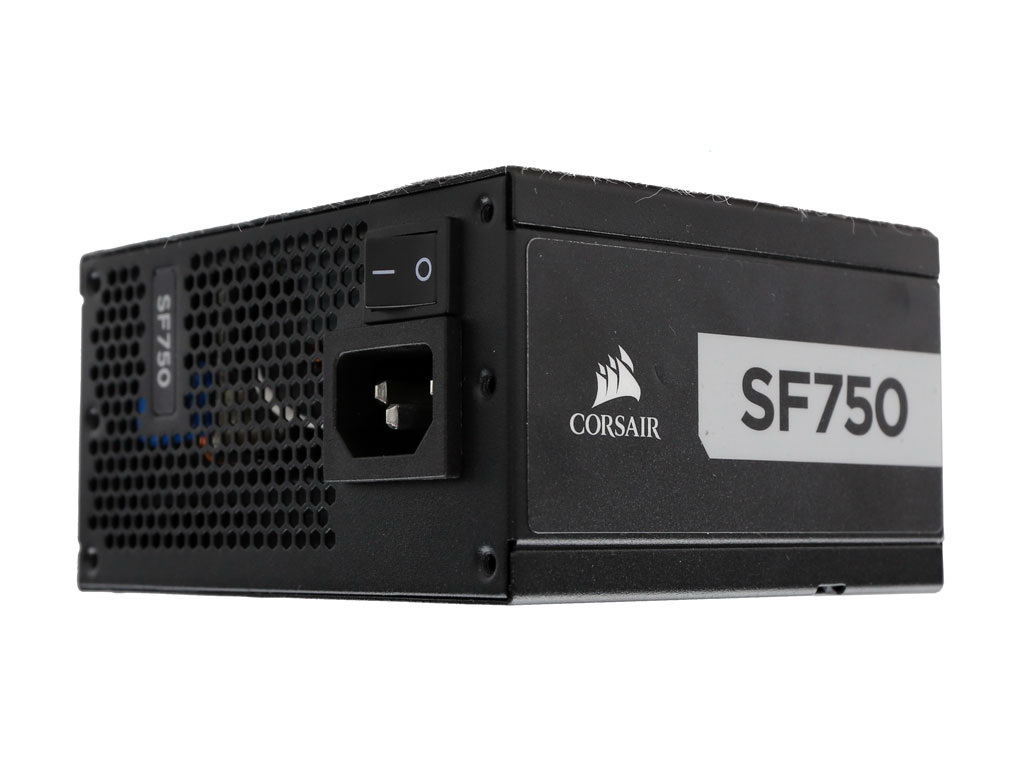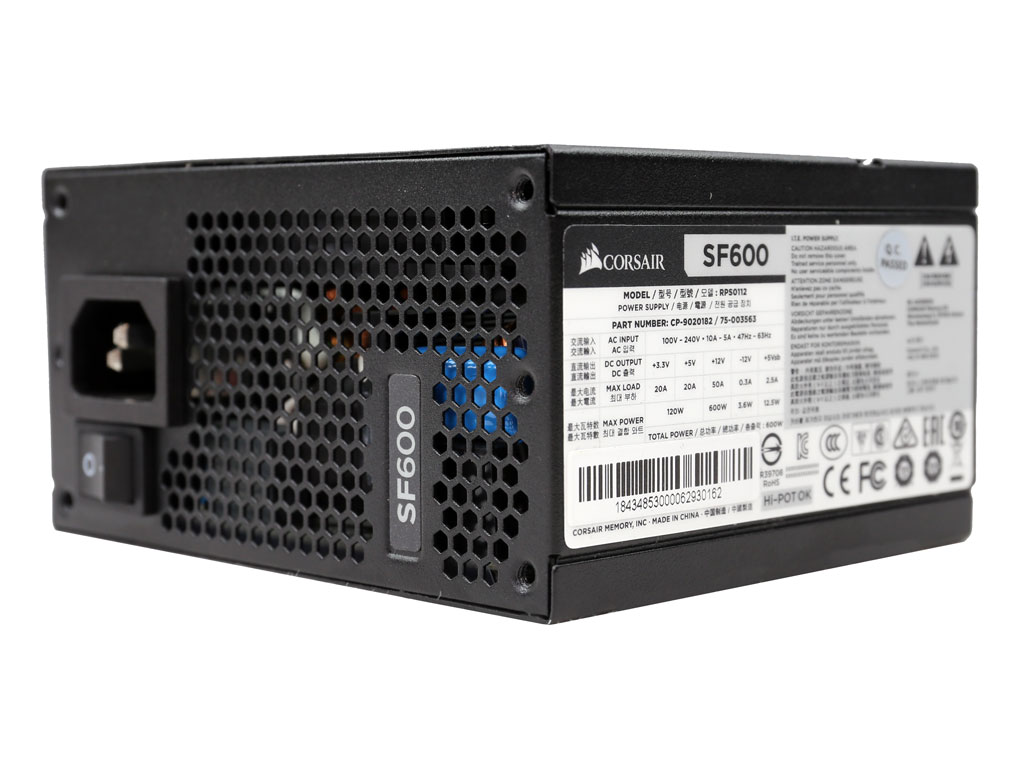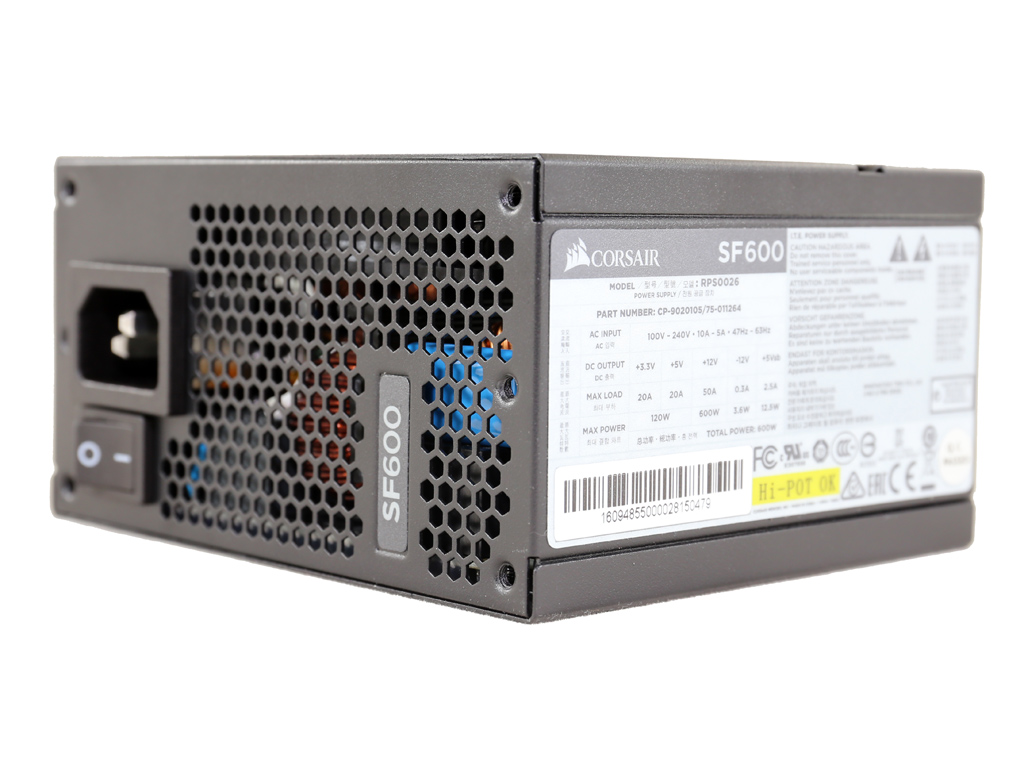Enermax D.F. 500W PSU Review
The Enermax D.F. 500W is a fully modular PSU featuring high efficiency, quiet operation, and individually sleeved cables. But are those enough to justify its premium price tag?
Why you can trust Tom's Hardware
Load Regulation, Hold-Up Time, And Inrush Current
To learn more about our PSU tests and methodology, please check out How We Test Power Supply Units.
Primary Rails And 5VSB Load Regulation
Load Regulation testing is detailed here.
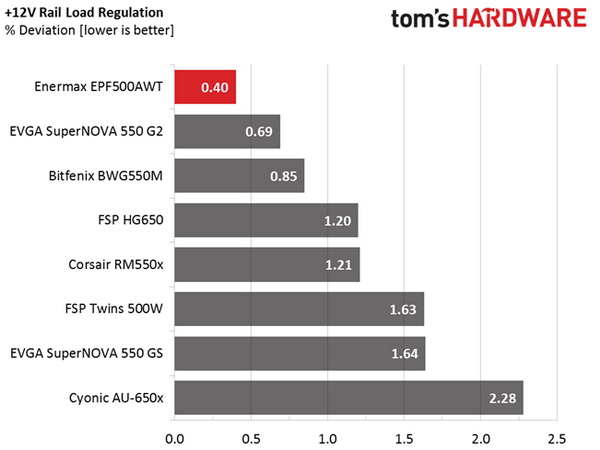
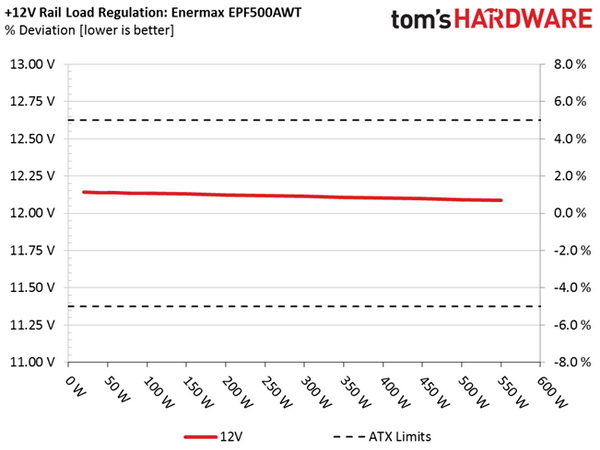
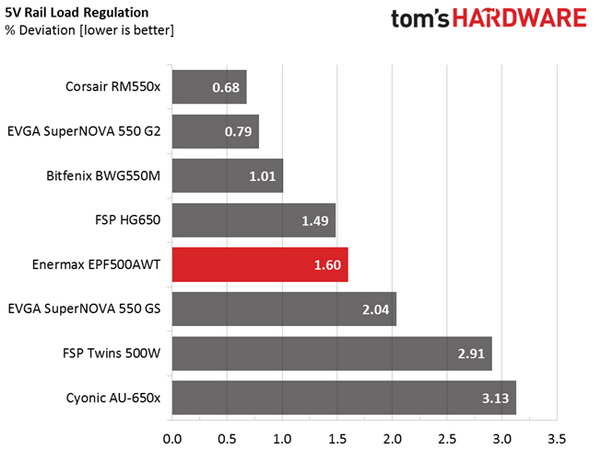
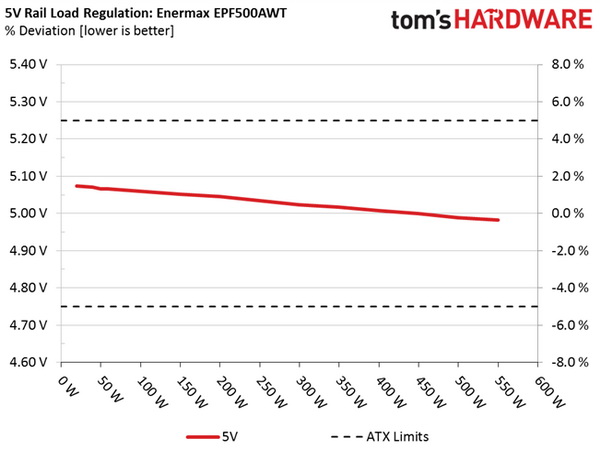
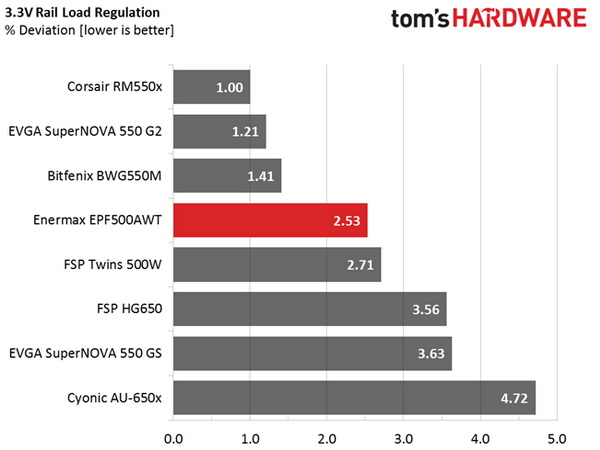
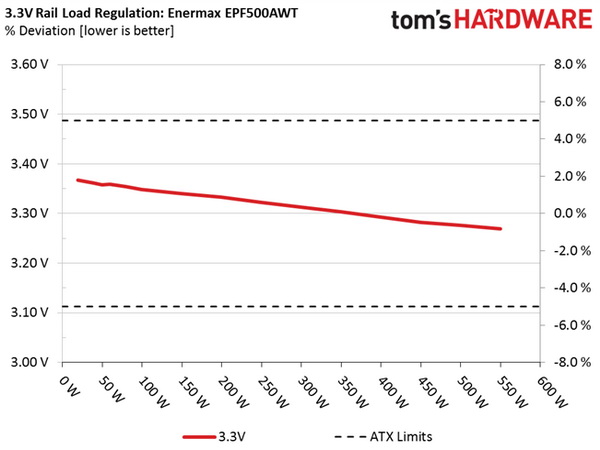
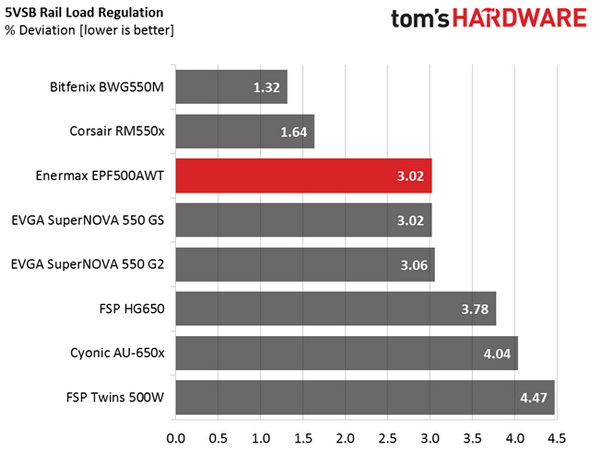
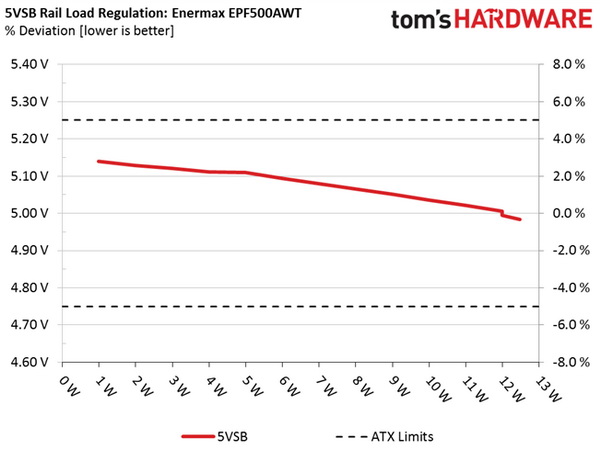
Hold-Up Time
Our hold-up time tests are described in detail here.
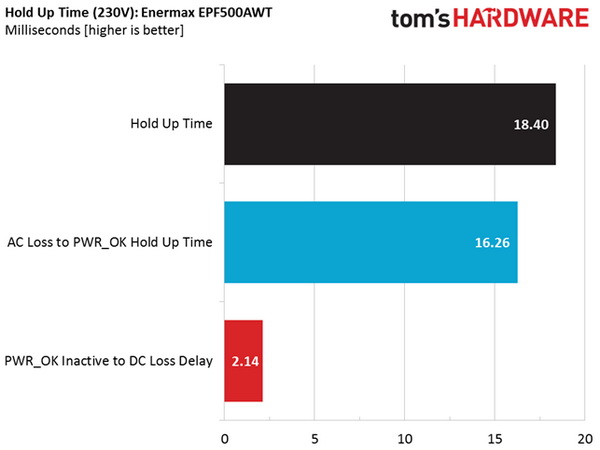
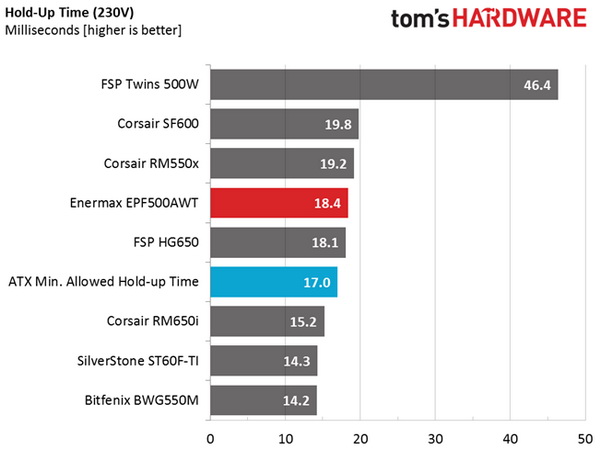
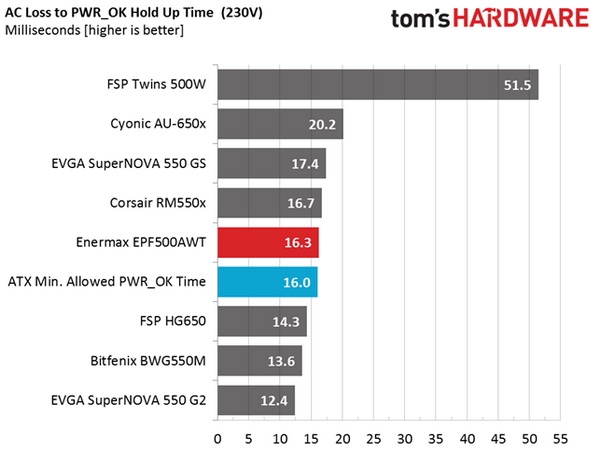
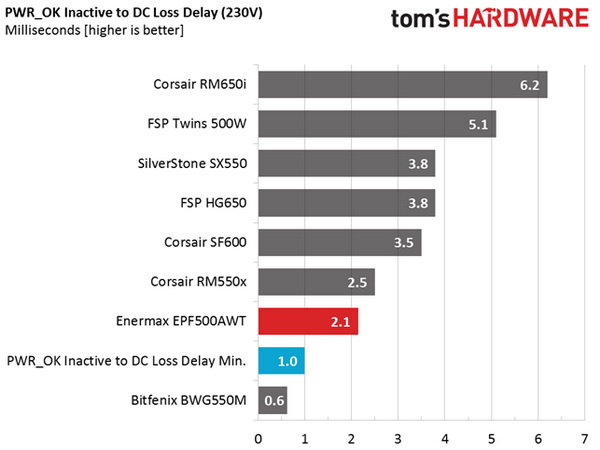
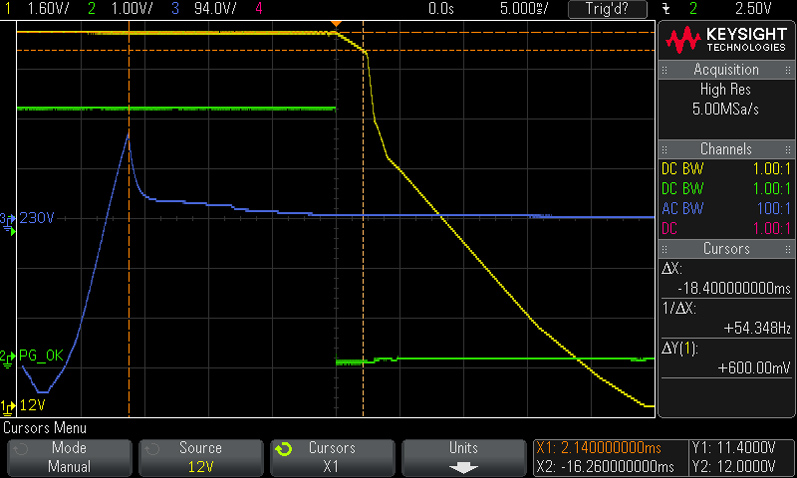
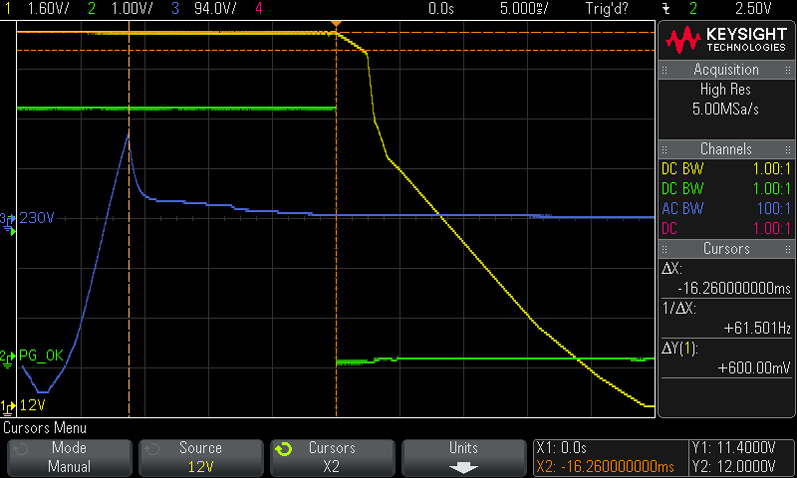
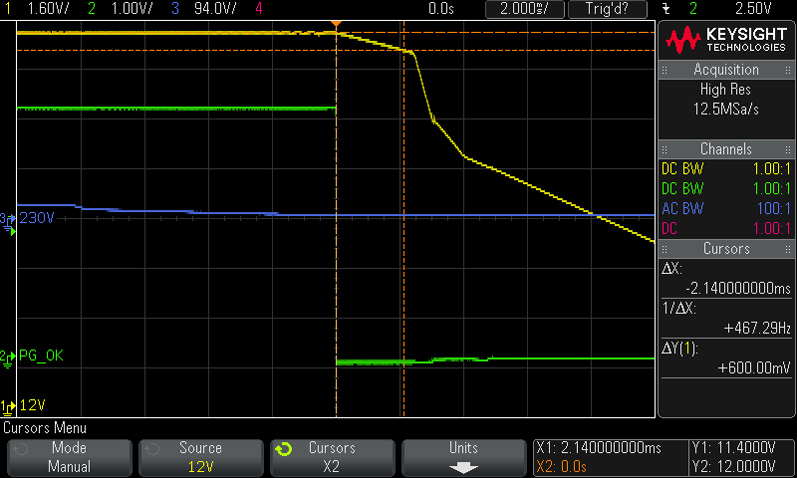
Despite a small bulk cap, the EPF500AWT's hold-up time easily exceeds 17ms, satisfying the ATX spec. The power-good signal also lasts more than 16ms, and it's accurate, dropping before the rails go out of spec.
Inrush Current
For details on our inrush current testing, please click here.
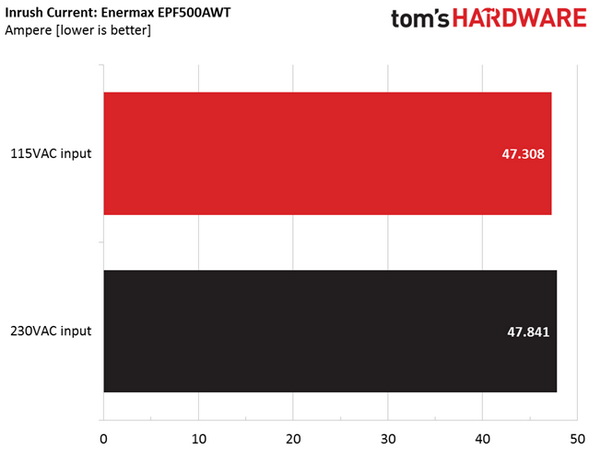
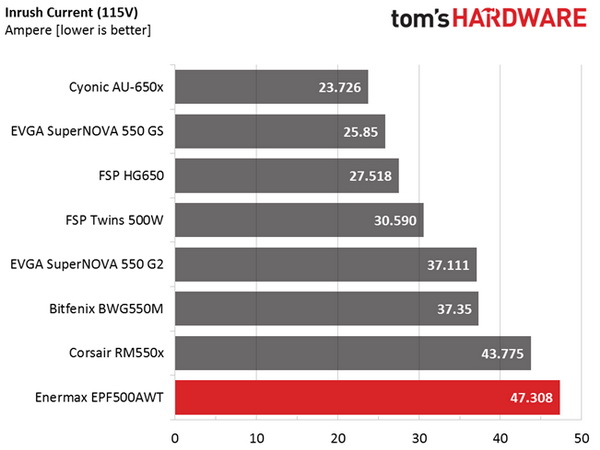
Measured inrush current is quite high, given the PSU's moderate capacity.
Load Regulation And Efficiency Measurements
The first set of tests reveals the stability of the voltage rails and the EPF500AWT's efficiency. The applied load equals (approximately) 10 to 110 percent of the PSU's maximum load in increments of 10 percentage points.
Get Tom's Hardware's best news and in-depth reviews, straight to your inbox.
We conducted two additional tests. During the first, we stressed the two minor rails (5V and 3.3V) with a high load, while the load at +12V was only 0.1A. This test reveals whether a PSU is Haswell-ready or not. In the second test, we determined the maximum load the +12V rail could handle with minimal load on the minor rails.
| Test # | 12V | 5V | 3.3V | 5VSB | DC/AC (Watts) | Efficiency | Fan Speed | Fan Noise | Temps (In/Out) | PF/AC Volts |
|---|---|---|---|---|---|---|---|---|---|---|
| 1 | 2.323A | 1.973A | 1.963A | 0.976A | 49.776 | 86.006% | 580 RPM | 20.8 dB(A) | 37.07°C | 0.930 |
| 12.140V | 5.066V | 3.358V | 5.109V | 57.875 | 41.44°C | 115.05V | ||||
| 2 | 5.679A | 2.958A | 2.952A | 1.177A | 99.758 | 90.413% | 580 RPM | 20.8 dB(A) | 38.46°C | 0.963 |
| 12.135V | 5.059V | 3.348V | 5.094V | 110.336 | 43.09°C | 115.04V | ||||
| 3 | 9.384A | 3.465A | 3.470A | 1.376A | 149.914 | 91.522% | 580 RPM | 20.8 dB(A) | 39.29°C | 0.972 |
| 12.130V | 5.052V | 3.340V | 5.080V | 163.801 | 44.16°C | 115.04V | ||||
| 4 | 13.081A | 3.963A | 3.959A | 1.576A | 199.768 | 91.853% | 600 RPM | 21.4 dB(A) | 39.20°C | 0.973 |
| 12.124V | 5.045V | 3.333V | 5.066V | 217.487 | 44.62°C | 115.04V | ||||
| 5 | 16.445A | 4.970A | 4.964A | 1.781A | 249.787 | 91.768% | 720 RPM | 24.5 dB(A) | 39.58°C | 0.976 |
| 12.118V | 5.034V | 3.322V | 5.051V | 272.194 | 45.44°C | 115.06V | ||||
| 6 | 19.806A | 5.971A | 5.975A | 1.985A | 299.700 | 91.446% | 920 RPM | 31.7 dB(A) | 40.27°C | 0.981 |
| 12.113V | 5.024V | 3.313V | 5.036V | 327.734 | 46.44°C | 115.05V | ||||
| 7 | 23.178A | 6.981A | 6.990A | 2.191A | 349.729 | 91.042% | 930 RPM | 32.1 dB(A) | 41.48°C | 0.985 |
| 12.107V | 5.017V | 3.303V | 5.021V | 384.142 | 48.22°C | 115.07V | ||||
| 8 | 26.542A | 7.991A | 8.013A | 2.396A | 399.654 | 89.748% | 940 RPM | 32.3 dB(A) | 41.99°C | 0.990 |
| 12.104V | 5.007V | 3.293V | 5.005V | 445.307 | 50.47°C | 115.07V | ||||
| 9 | 30.346A | 8.502A | 8.558A | 2.402A | 449.682 | 89.381% | 940 RPM | 32.3 dB(A) | 42.92°C | 0.992 |
| 12.097V | 4.999V | 3.282V | 4.995V | 503.106 | 53.08°C | 115.08V | ||||
| 10 | 34.101A | 9.028A | 9.064A | 2.504A | 499.564 | 88.876% | 940 RPM | 32.3 dB(A) | 43.77°C | 0.994 |
| 12.092V | 4.989V | 3.276V | 4.984V | 562.091 | 54.59°C | 115.08V | ||||
| 11 | 38.249A | 9.038A | 9.080A | 2.512A | 549.573 | 88.290% | 940 RPM | 32.3 dB(A) | 44.78°C | 0.995 |
| 12.088V | 4.983V | 3.269V | 4.976V | 622.462 | 59.10°C | 115.08V | ||||
| CL1 | 0.099A | 12.011A | 12.003A | 0.005A | 101.674 | 86.913% | 940 RPM | 32.3 dB(A) | 43.57°C | 0.966 |
| 12.139V | 5.038V | 3.327V | 5.107V | 116.984 | 50.52°C | 115.08V | ||||
| CL2 | 40.958A | 1.003A | 1.001A | 1.003A | 508.577 | 89.619% | 940 RPM | 32.3 dB(A) | 44.27°C | 0.994 |
| 12.090V | 5.012V | 3.301V | 5.048V | 567.489 | 57.19°C | 115.08V |
Load regulation at +12V is tight, and it's merely satisfactory on the other rails. The fan's noise remains at low levels, even when we push the PSU to its limits (and above them). Enermax's fan does a fine job, given the large temperature deltas that our equipment recorded.
As for efficiency, the EPF500AWT clears our 20% load test easily. It also comes close to the 80 PLUS Platinum certification's requirements in the 50% and 100% load tests. After all, 80 PLUS tests at a very low ambient, so it's natural to see worse results when we test at more realistic temperatures.
Current page: Load Regulation, Hold-Up Time, And Inrush Current
Prev Page A Look Inside And Component Analysis Next Page Efficiency, Temperature, And Noise
Aris Mpitziopoulos is a contributing editor at Tom's Hardware, covering PSUs.
-
eglass I'd probably buy it. I like those cables and I'm running a 500W Enermax Liberty that is now 11 years old.Reply -
Anathemata How well does the dust-removal feature work? I mean, Van der Waals force is still a thing, and you need more than just a simple fan to blow out dust. Wouldn't a simple filter suffice?Reply
The sleeved cables are a nice touch. It'll be cheaper than buying a different power supply and separate sleeved cables. -
daddywalter Build quality isn't bad but could be better; lack of OTP is troublesome; and I'll agree with the reviewer that sleeved cables would be better offered as an option for modders. 80 Plus Platinum rating is a plus, of course; and 500 watts is adequate for most general-purpose computers that don't require multiple GPUs -- this PSU would probably outlast most SOHO builds, but then the initial price becomes more of a factor. Nice PSU, but IMHO not worth $140 with only a five-year warranty; at ten years I might consider it since then it should be good for at least three builds.Reply -
dstarr3 Reply19274544 said:I'd probably buy it. I like those cables and I'm running a 500W Enermax Liberty that is now 11 years old.
11 years is plenty of time for a company to have since dropped an amount of build quality. -
Robert Cook I'll add my voice, that auto play video needs to go. It is obnoxious, and adds lag to weaker devices.Reply
I like that cable pattern, it reminds me of the cables on my Enermax revolution 85+ 850W. (a great PSU despite its lower efficiency and age.)
How are poorly trimmed leads going to cause shorts if everything is locked inside a case? I only see that as an issue if you go dropping screws in there. -
Aris_Mp they aren't poorly trimmed only, some of them are really long and only a hair away from the other. Under extreme conditions this can cause problems (shorts) and there can be of course an EMI issue when leads are so close to each other. Also with such long leads the plastic shield under the PCB can get punctured or during the PCB's installation into the chassis, which applies pressure to the leads, the long ones will bend and probably get shorted; this means that some PSUs might be already broken. I don't think that every PSU that leaves the production line is tested, but only a percentage of them.Reply
There is a purpose behind the proper trimming of excessively long leads in every PCB that is installed into a metallic chassis. The use of a plastic shield under the PCB doesn't automatically solves all possible problems. -
WFang I'm hoping for a resurgence in power supply choices in the 500W and *LESS* category!Reply
I would rather see something like the amazing Seasonic Prime supplies in a 400W flavor than 600W and over...
Before I go on, I realize that if you run two GPU's or you really like to OC, obviously you need more and want more.. Great.. you already have a ton of great choices for those use-cases... I just wonder why we don't have more great quality choices in the lower Wattage ranges where probably a good 75% of even the enthusiast group could live comfortably.
I also realize that TDP - Thermal Design Power is NOT the same as power consumption, but it is easy to find TDP numbers, and a part that is designed to deal with e.g. 100W TDP is likely to consume around 100W (or less) even in peak. As such it becomes a handy metric for back of the envelope power budgeting that still ends up being fairly conservative.
With CPU's now more often in the lower half of 45W, 65W, and 95W TDP and the more recent GPU's all sitting at 300W or less in TDP, I'd argue that for non-OC'ed systems with one GPU and 1 or 2 HDD's and maybe an SSD, a great high efficiency 350W to 400W PSU will be a great choice. Feeling like that is pushing it? Fine, go 500W... but I don't see why you'd shop higher than that (for this use-case). Yet, good quality Titanium, Platinum, or Gold efficiency PSU's seem so hard to find in the sub 500W range. :(
On a side note, since I'm here complaining anyway: A looong time ago I heard Tom's mention the Seasonic Prime 600W fanless PSU, anyone know if/when that will become available in the US? (Or anywhere?)??? -
Marcus52 Reply19274544 said:I'd probably buy it. I like those cables and I'm running a 500W Enermax Liberty that is now 11 years old.
Enermax was my favorite PSU maker when they made their own, but unfortunately they've chosen OEMs that are "adequate" not "great" to replace their manufacturing facility. I've paid their premium in the past, but right now EVGA is on the top of my list. Super Flower makes their top-of-the-line PSUs and build quality is superb, as are test bench results.
Seasonic is also on my list of "will buy", and several other brands use Seasonic or Super Flower, so I wouldn't be opposed to buying one from someone like Corsair - as long as it tested well on reputable hardware sites.
Never buy a PSU that doesn't review well. I've learned that the hard way. Build quality matters.
